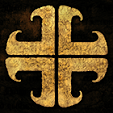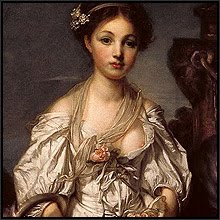 Dutch Artist George Hendrik Breitner called his painting (above) Seated Half-Nude. His model is 'half-nude' because the artist shows the woman in the act of removing her chemise - an intimate moment. We might normally think that with such a private gesture she would be 'half-naked', and yet Breitner's title alone tells us that she is 'nude', and not 'naked'. Where does the difference lie? For me, it lies in the artist's own attitude, and in his treatment here of the painting itself. Breitner's brushwork is so chiselled and monumental, the forms so sculpted in paint, that he lifts his model away from the everyday through the sheer force of his artistry. The woman whom we see in the canvas is at the same time both an individual - the artist's model - and a more universal 'everywoman': a created form which emerges from the paint in slabs of light and shadow. It is this 'more than the everyday world' aura that makes this woman 'nude'.
Dutch Artist George Hendrik Breitner called his painting (above) Seated Half-Nude. His model is 'half-nude' because the artist shows the woman in the act of removing her chemise - an intimate moment. We might normally think that with such a private gesture she would be 'half-naked', and yet Breitner's title alone tells us that she is 'nude', and not 'naked'. Where does the difference lie? For me, it lies in the artist's own attitude, and in his treatment here of the painting itself. Breitner's brushwork is so chiselled and monumental, the forms so sculpted in paint, that he lifts his model away from the everyday through the sheer force of his artistry. The woman whom we see in the canvas is at the same time both an individual - the artist's model - and a more universal 'everywoman': a created form which emerges from the paint in slabs of light and shadow. It is this 'more than the everyday world' aura that makes this woman 'nude'. This study (above) by contemporary digital artist Craig Mullins displays the same freedom of brushwork - although in this case the artist's 'brush' is a digital one. And Mullins, every bit as much as Breitner before him, is 'at work' here. We feel in the brush lines the striving to understand and describe the planes of the model's body: the arch of the back, the skin stretched taught below the rib cage. The artist is not out to capture feminine beauty, but to reach an understanding of the forms which the model's anatomy describes. And again, as with Breitner's model, Mullins is little concerned with a portrait of a specific individual. The woman's face is articulated with the same rough but incisive brushwork as the rest of the figure.
This study (above) by contemporary digital artist Craig Mullins displays the same freedom of brushwork - although in this case the artist's 'brush' is a digital one. And Mullins, every bit as much as Breitner before him, is 'at work' here. We feel in the brush lines the striving to understand and describe the planes of the model's body: the arch of the back, the skin stretched taught below the rib cage. The artist is not out to capture feminine beauty, but to reach an understanding of the forms which the model's anatomy describes. And again, as with Breitner's model, Mullins is little concerned with a portrait of a specific individual. The woman's face is articulated with the same rough but incisive brushwork as the rest of the figure. With the treatment of the nude by Boris Zaborov (above) we are in a radically different setting. Here this removal of the figure from the everyday world is pushed even further by the artist's use of a neutral background. It could be anywhere, at any time and place. Contradictorily, Zaborov's model is a specific individual, her face anything but anonymous. She gazes steadily out at us from her drifting world, as if afloat in a passing dream.
With the treatment of the nude by Boris Zaborov (above) we are in a radically different setting. Here this removal of the figure from the everyday world is pushed even further by the artist's use of a neutral background. It could be anywhere, at any time and place. Contradictorily, Zaborov's model is a specific individual, her face anything but anonymous. She gazes steadily out at us from her drifting world, as if afloat in a passing dream.But why need the figure be nude at all? Another often-asked question. Different artists will give different reasons, but my own reaction is again to do with this removal from the everyday. The clothes we wear express much, both about who we are as individuals, and about the time and the place in which we live. For this reason, models who are fully-clothed become 'portraits' almost by default. Clearly, with a nude model there must be another factor at work.
 In a very real sense, to step out of one's everyday clothes is to step out of time - to remove oneself from any context with the everyday world. To be nude is not to be naked. It is for this very reason that for a model to be nude can prove to be an empowering experience. Javier Valhonrat's composition (above), from his Possessed Space series, is a clear example. However 'boxed-in' the artist has chosen to portray her, this model in her nudity has all the freedom to occupy an 'eternal now'. For her to have worn even so much as basic underwear would have looked ludicrous, and this is what we sense.
In a very real sense, to step out of one's everyday clothes is to step out of time - to remove oneself from any context with the everyday world. To be nude is not to be naked. It is for this very reason that for a model to be nude can prove to be an empowering experience. Javier Valhonrat's composition (above), from his Possessed Space series, is a clear example. However 'boxed-in' the artist has chosen to portray her, this model in her nudity has all the freedom to occupy an 'eternal now'. For her to have worn even so much as basic underwear would have looked ludicrous, and this is what we sense.So if all these images are what being 'nude' is about, and if we can define it through these examples, where does that leave 'naked'? If nudity removes someone from the everyday, then nakedness must do the opposite. And indeed: you are naked if you are about to climb into bed with your lover. You are naked if you are about to step under the shower. And if you as a model leave your clothes in a neat pile on a chair of the artist's studio, and step forward with the thought that you are serving the needs of art, then with that step you leave the everyday world to become empoweringly nude!













































































